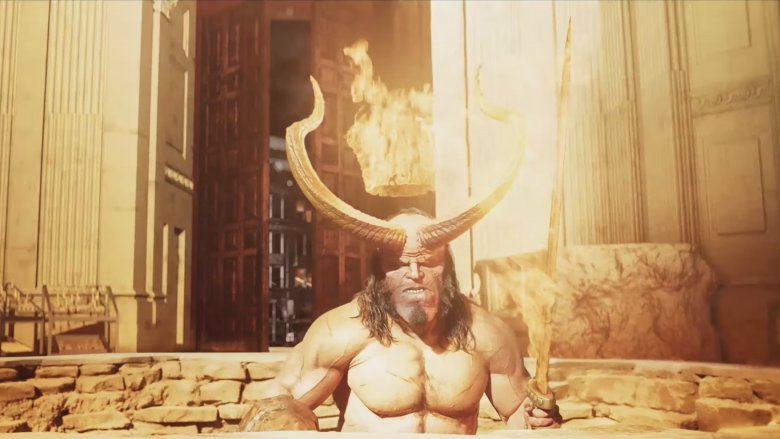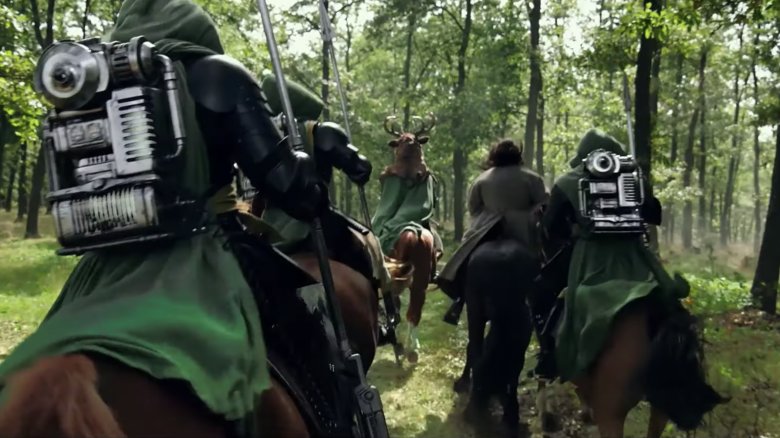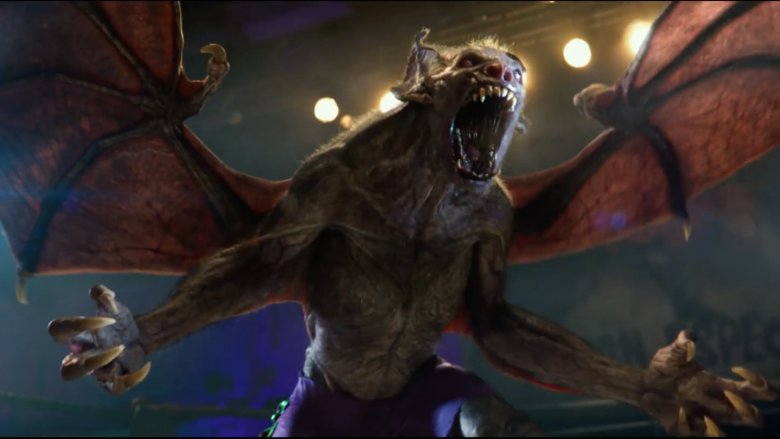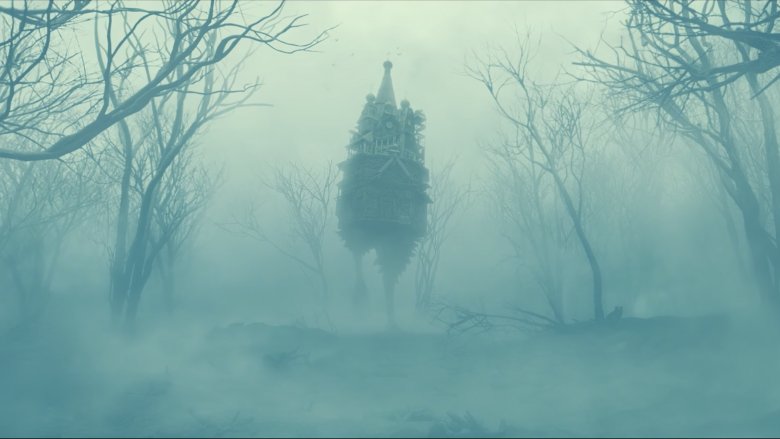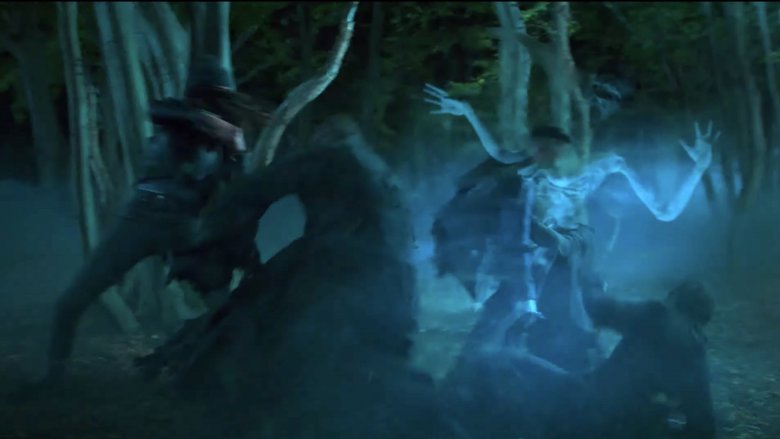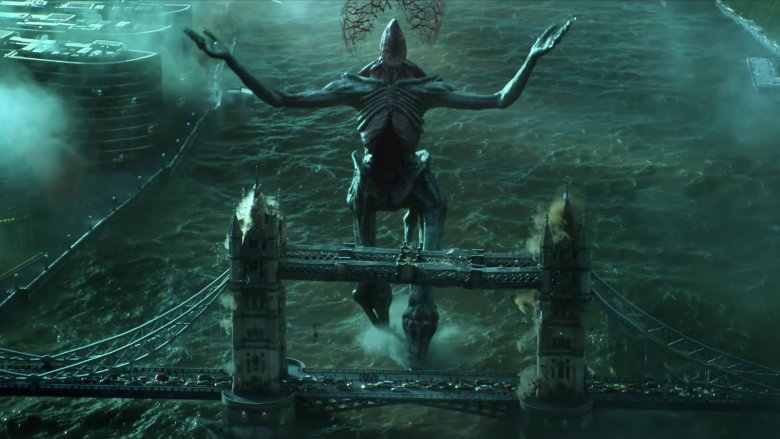Hellboy Red Band Trailer Details You Missed
The first two Hellboy movies, directed by Guillermo del Toro and starring Ron Perlman, are fan favorites and brought the lovable demon and the world of the BPRD to the masses. Now, Hellboy is getting a second lease on life at the multiplex, with Neil Marshall (The Descent) at the helm and David Harbour (Stranger Things) donning the red makeup and giant world-ending fist. The new film is an R-rated affair — bathed in blood and cursing, if the red band trailer is to be believed.
From the looks of it, this new adaptation takes heavy inspiration from the Hellboy comics The Wild Hunt, The Storm and the Fury, and possibly even Hellboy in Hell. These stories involve giants, King Arthur, Nimue the Blood Queen (played in the film by Milla Jovovich), and the end of the world as we know it. This clip does a magnificent job of setting the new tone, showing off Harbour's wry take on Hellboy and the cataclysmic danger in the world created by Mike Mignola and his numerous collaborators. It also hints at deeper lore, with winks and nods to the decades and decades of adventures that Hellboy as had, and maybe even hints at the future of the rebooted franchise. With all that in mind, here's a look at all the small details you might have missed in the red band Hellboy trailer.
Long live the king
Normally, a character in a comics adaptation getting a giant flaming sword would just be a cool image to put onscreen — something flashy for the trailer. It's still cool, but the blazing blade that Hellboy wields in the red band trailer is a little more than just a cool effect. It's almost certainly meant to be the mythical blade Excalibur. "But that's a King Arthur thing!" you might find yourself thinking. You'd be right, and you're still right as far as the Hellboy universe is concerned.
In The Wild Hunt, it was revealed that not only can Hellboy wield Excalibur, but he can do so because he is a descendant of King Arthur and the true, rightful heir of the British Isles. As far as wild reveals go, this may be one of the wildest in Hellboy history, so it's pretty exciting to see it being presented on the big screen and goes to show that the new Hellboy flick isn't just a departure from the tone of the Guillermo del Toro films — it's also willing to dig deep into the wide, weird world that Mike Mignola and his collaborators have crafted over the years. It'll be interesting to see if Hellboy takes things to this logical conclusion, what with all the flaming crown imagery and Nimue the Blood Queen intoning "be my king" as the world falls apart around everyone.
The Wild Hunt
The Osiris Club is just one of many mysterious organizations in the world of Hellboy. A group formed out of the ashes of the Heliopic Brotherhood of Ra (another mysterious organization), its members were given immortality and a prophecy about a reluctant king who would die leading an army into a battle at the end of days. At one time the Osiris Club believed Hellboy was the person spoken of in the prophecy, going so far as to test his mettle against a dragon that was previously slain by a saint. Even though Hellboy was able to kill the beast, the Osiris Club remained uncertain of the veracity of the prophecy — at least as far as he was concerned.
In the modern day, Hellboy is again invited to England by the club. This time, it's to join in on the tradition of the Wild Hunt. The Osiris Club can be seen in the new trailer on a hunt for giants astride horseback, decked in some very arthurian green and white tabards and led by a knight wearing the head of a stag. The existence of the Osiris Club in the film tracks with Nimue and the possibility of Hellboy wielding Excalibur. One thing's for sure, the Osiris Club never means good things for Hellboy, especially with their belief that if their doomsday prophecy comes to pass, they will be able to survive and possibly even thrive in the end times.
Hellboy in Mexico
In a blink-and-you'll-miss-it moment, eagle-eyed viewers may have caught a flash of a giant bat-like creature standing in a wrestling ring. Not only is this rad, but it hints at a fan-favorite one-shot story, Hellboy in Mexico. While the shot may just be from a montage showing various adventures of this Hellboy, there's a chance we might get the whole story in the movie, which would work as a great departure from the main story — which looks to have the stakes ratcheted up as high as they can go, with a giant monster towering over London as Hellboy flies a dragon over a hellacious landscape.
Hellboy in Mexico details Hellboy getting real with Abe Sapien about one of the strangest and most difficult times in his life. While in Mexico in the 1950s, he got in deep with a trio of brothers who also happen to be luchadors. These luchadors are more than your average masked wrestlers, they also hunt monsters because they received a vision from the Virgin Mary (and that's not really an invitation most people are going to turn down). Hellboy joins them on their quest, which entangles him with ancient Mayan temples and vampire luchadors. A sweet epilogue gives readers a glimpse into what life could have been like had Hellboy stopped hunting monsters — donning a mask and wrestling for the adoration of the crowd. While It's unlikely we'll see the whole tale told in Hellboy, even referencing it (among other adventures) will help give viewers a deeper understanding of the scope of Hellboy's adventures since World War II.
Fear the Baba Yaga
One of the most striking images in the entire trailer is the appearance of a house, conspicuously trotting along on a pair of slender, spindly chicken legs. As bizarre of an image as the tottering home may be, nothing can quite compare to how truly strange its inhabitant is. The chicken leg house is home to none other than the Baba Yaga, the notorious witch of eastern European folklore.
In the Hellboy universe, the Baba Yaga is known to be incredibly powerful. She's a fearsome witch who is mostly known for dealing in magic that involves spirits and souls. She has an army of undead at her beck and call, which could be pertinent to Hellboy, since in the trailer there's a fearsome army of shambling corpses in what we can assume is London being besieged by dark forces. It's unknown exactly what role the Baba Yaga will play in the film, but in the comics, Hellboy and the dastardly witch have crossed paths a handful of times. During their first encounter, Hellboy actually wounds the Baba Yaga, blinding her in one eye and forcing her to retreat from Earth. She's operated from the shadows throughout the Hellboy series, intersecting with all sorts of villains and beasties over the years.
Punching the soul right out of your body
In Hellboy, Alice Monaghan appears to be a field agent in the employ of the BPRD. From most of what's been shown of the movie, there doesn't seem to be anything too quirky or special about Alice — that is, until she punches someone so hard their spirit flies out of them. There's a chance this could have something to do with the flashy, appropriately BPRD-branded brass knuckles she sports in the trailer. There's also a chance that this hints at her comic book roots as a person deeply affected by and connected to the fae.
In the 1995 Hellboy comic The Corpse, Hellboy must rescue Alice as a young child after she's kidnapped by the King of the Faeries. After being saved, one of the faeries reveals to Hellboy that they were going to raise Alice as their own child because something has gone gravely wrong and faeries are no longer able to have children. Alice doesn't reappear until 2008 in The Wild Hunt, showing a fascinating amount of restraint and forethought on Mike Mignola's part. In The Wild Hunt, Hellboy meets Alice again and remarks at how young she looks even though decades have passed, indicating that her time with the fae has somehow altered her. Through the effects of Nimue's treachery, Alice essentially becomes the new Queen of the Fairies and struggles to provide sanctuary for the fae as the world literally goes to hell. Movie Alice may not end up having as grand a role as she does in the comics, but this simple shot from the trailer at least hints at a supernatural connection for the character.
Hell on Earth
It's tough to tell if the giant entity summoned by Nimue is an aspect of the Ogdru Jahad or not, but it's likely that the pale, skinless-looking beast is meant to be something similar to the Ogdru Jahad of the Hellboy comics if not the real deal. The Ogdru Jahad are about as bad as bad guys get. They're what you'd end up with if you took equal parts of H.P. Lovecraft's Old Ones and The Beast of Christian mythology and threw them in a blender with a little bit of Mignola's impeccable sense for the horrific and the terrifying. The Ogdru Jahad represents one thing and one thing only: The End of Everything.
Many of Hellboy's villains have been working to summon The Ogdru Jahad, whether intentionally or under their sway. Heck, Hellboy's own summoning was the result of an Ogdru Jahad ritual gone slightly awry. The members of Project Ragna Rok weren't looking for just any old demon. They wanted the worst of the worst. Whatever the massive entity that's annihilating London in the trailer actually is, it's definitely linked to the end times and the prophecy of the Osiris Club. So much of what is shown in the trailer hints at bad, bad things for Hellboy, up to and including his own death — leading up to the happenings of Hellboy in Hell. It's a pretty wild idea to start the new movie series at such a pivotal point in the character's storied history, but it's exciting to see the filmmakers tackle such a meaty story with so many fun avenues to explore.
